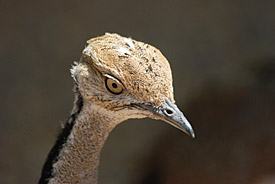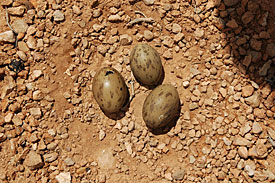Press release June 24, 2010
Pleasing to the eye
Even brooding female birds are sensitive to visual stimulation
Missour/Leipzig. In a breeding experiment with Houbara Bustards ‒ a North African bird species with a very distinctive courtship behaviour, scientists have concluded that visual stimulation from attractive males of the same species positively affects brooding females, improving offspring growth. Females that observed highly displaying male birds in the experiment were more fertile and had a greater breeding success due to an increased allocation of testosterone into their eggs, leading to an increase in the growth rate in chicks. The results showed that using artificial insemination without appropriate stimulation of breeding females probably has negative impacts on their breeding performance and can therefore even affect the survival of a species, according to Adeline Loyau and Frederic Lacroix in the online edition of Proceedings of the Royal Society B.

The Houbara Bustard is a sandy-coloured resident of deserts, with its distribution ranging from North Africa to Mongolia
Photo: Adeline Loyau/ UFZ/CNRS

Eggs of the Houbara Bustard. In a breeding experiment with Houbara Bustards scientists have concluded that visual stimulation from attractive males positively affects brooding females, improving offspring growth.
Photo: Adeline Loyau/ UFZ/CNRS
For the experiment, Loyau of the Helmholtz Center for Environmental Research (UFZ) and the French CNRS station for experimental ecology and her colleague Lacroix (ECWP) confronted 90 brooding Houbara Bustard females (Chlamydotis undulata undulata) with various individuals of the same species. In the Emirates Center for Wildlife Propagation (ECWP) in Moroccan Missour, 30 female birds were visually confronted with either highly displaying male birds, poorly displaying male birds, or females. During the experiment the female birds under investigation were artificially inseminated and kept isolated in aviaries five meters apart from birds of the same species in other aviaries. That way the scientists were able to exclude any other factors from playing a role in the experiment other than that of visual stimulation. "To my knowledge our study is the first example in species conservation of a successful manipulation of maternal allocation of resources through sensory stimulation ", explains behavioural biologist Adeline Loyau from the UFZ, "Our results show that it is possible to control maternal allocation of resources independent of the quality of male genes." Male display courtship constitutes an effective signal thereby providing conservationists with a simple and inexpensive means. The results could therefore be very significant for the improvement of captive breeding programs of other threatened bird species.
The Houbara bustard is a sandy-coloured resident of deserts, with its distribution ranging from North Africa to Mongolia. In the Arab world it is common prey for falcon hunting. Both hunting and a loss of habitat have diminished Houbara bustard populations and in the meantime the species is classified as vulnerable. It is bred in captive breeding programs to support the conservation of in-situ populations. It was for this purpose that the Emirates Center for Wildlife Propagation (ECWP) was founded in Moroccan Missour by the emir of Abu Dhabi, sheikh Zayid bin Sultan Al Nahyan.
Already in 2007, Adeline Loyau and colleagues found that females of the Blue Peacock (Pavo cristatus) that had mated with attractive males increased the allocation of resources
into their eggs compared to females that had mated with unattractive males. With attractive partners they laid larger eggs and increased the yolk testosterone levels, which has a
direct influence on the growth rate of offspring. Generally, it is known that various factors can have an effect on female birds and their offspring such as the quality of male
genes or food availability. Under unfavourable conditions it can be more effective to invest less in the current offspring but to put more effort into the following season.
With their most recent experiment Loyau and Lacroix were finally able to show that visual stimulation can also influence chick growth. The data were analysed by Loyau in the
laboratories of the UFZ in Leipzig during her time there as a visiting researcher. In the meantime the French biologist is working at the station for experimental ecology (SEEM)
of the French Research Center CNRS in Moulis in the Pyrenees.
Tilo Arnhold
The United Nations have declared 2010 as the ‘International Year of Biodiversity’. The goal of this is to bring the issue of biodiversity with its many facets to the collective conscience of the public. With its expertise the UFZ contributes to investigating the consequences and causes of the loss of biodiversity as well as developing mitigation options.
Biodiversity research in Germany is conducted at numerous institutions ranging from universities, non-university research institutes and departmental research to nature conservation organisations and companies. The Network Forum on Biodiversity Research is a project in the context of DIVERSITAS Germany that intends to offer the research community a common institution-independent communication structure and culture. For more information see:
Publication
Adeline Loyau and Frederic Lacroix (2010):
Watching sexy displays improves hatching success and offspring growth through maternal allocation. Proceedings of the Royal Society B.
http://dx.doi.org/10.1098/rspb.2010.0473
http://rspb.royalsocietypublishing.org
Further information
Dr. Adeline Loyau
Station d'Ecologie Experimentale du CNRS
Tel. +33 5 61 04 03 73
www.ecoex-moulis.cnrs.fr/Staffpages/AdelineLoyau.htm
www.adeline-loyau.net
PD Dr. Klaus Henle
Helmholtz Centre for Environemental Research (UFZ)
Tel. +49 341 235 1270
PD Dr. Klaus Henle
oder
Helmholtz Centre for Environemental Research (UFZ)
Press office
Tilo Arnhold
Tel. +49 341 235 1269
presse@ufz.de
More links
Emirates Center for Wildlife Propagation
www.ecwp.org/vo/houbara_bustard.php
International Foundation for Conservation and Development of Wildlife (IFCDW)
http://houbara.com/english
Houbara Bustard
en.wikipedia.org/wiki/Houbara_Bustard
Mothers invest more in reproduction when their mates are attractive (Press release from July 19th, 2007)
www.ufz.de/index.php?de=14687
International Year of Biodiversity 2010:
www.cbd.int/2010/welcome
At the Helmholtz Centre for Environmental Research (UFZ), scientists research the causes and consequences of far-reaching environmental changes. They study water resources, biological diversity, the consequences of climate change and adaptation possibilities, environmental and biotechnologies, bio energy, the behaviour of chemicals in the environment and their effect on health, as well as modelling and social science issues. Their guiding research principle is supporting the sustainable use of natural resources and helping to secure these basic requirements of life over the long term in the context of global change. The UFZ employs 900 people at its sites in Leipzig, Halle and Magdeburg. It is financed by the German government and by the states of Saxony and Saxony-Anhalt.
The Helmholtz Association helps solve major, pressing challenges facing society, science and the economy with top scientific achievements in six research areas: Energy, Earth and Environment, Health, Key Technologies, Structure of Matter, Transport and Space. With nearly 28,000 employees in 16 research centres and an annual budget of around EUR 2.8 billion, the Helmholtz Association is Germany’s largest scientific organisation. Its work follows in the tradition of the natural scientist Hermann von Helmholtz (1821-1894).
The Station d’Ecologie Experimentale in Moulis (SEEM) is a recently founded research unit of the CNRS. It is located in the foothills of the Pyrenean region of Ariege.
The research focus of the station is animal dispersal and behaviour and any aspect of these. The station is well equipped comprising physiologic, genetic, and ecologic lab
facilities as well as experimental sites.
www.ecoex-moulis.cnrs.fr
